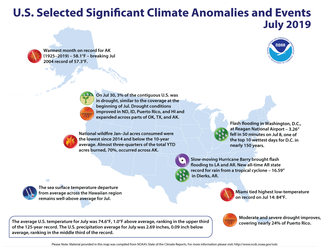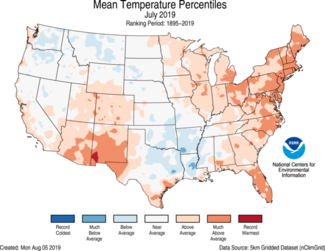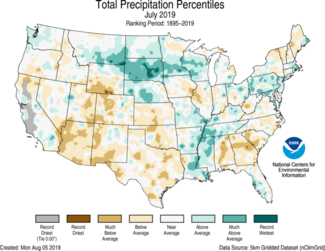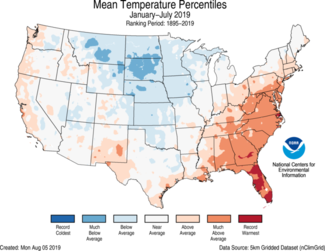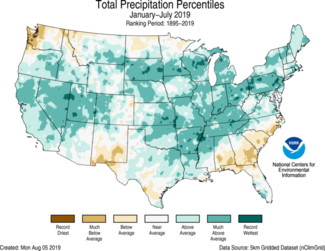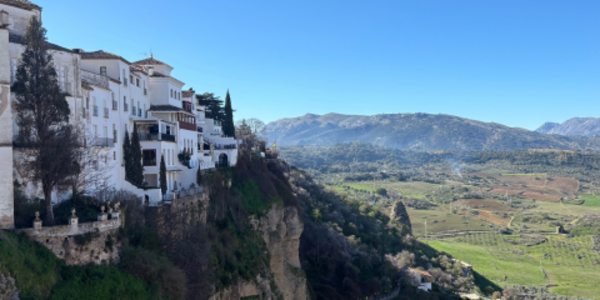Warmest month on record for Alaska
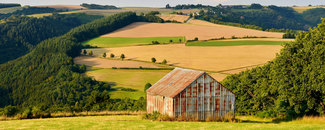
The July 2019 contiguous U.S. temperature was 74.6°F, 1.0°F above the 20th century average ranking in the upper third of the 125-year record. This tied with 1917 as the 27th warmest July for the contiguous United States. Alaska reported its warmest July and month on record with an average temperature of 58.1°F, 5.4°F above average and 0.8°F more than the previous warmest month, which occurred in July 2004. For the year-to-date, the national temperature was 51.5°F, 0.2°F above average, ranking in the middle third of the historical record.
The July precipitation total for the contiguous U.S. was 2.69 inches, 0.09 inch below average, and ranked in the middle third of the 125-year period of record. This was the first near-average precipitation month so far in 2019. The year-to-date precipitation total for the Lower 48 was 21.79 inches, 3.70 inches above average, ranking wettest on record. Despite the near-average July precipitation, the 12-month average precipitation across the contiguous U.S. for August 2018–July 2019 was 37.73 inches, 7.78 inches above average and the wettest August–July period on record. This also ranks as the second wettest among all 12-month periods on record behind the 37.90 inches of precipitation that fell during July 2018–June 2019.
This monthly summary from NOAA National Centers for Environmental Information is part of the suite of climate services NOAA provides to government, business, academia, and the public to support informed decision-making.
July Temperature
-
Above-average July temperatures stretched from the Great Lakes to New England and down to the Gulf Coast as well as across much of the Southwest. Seventeen states across the contiguous U.S. had July temperatures that were much-above-average, with Connecticut and Rhode Island ranking third warmest.
-
Below-average temperatures were present across parts of the Deep South and the Northwest.
-
In addition to Alaska’s warmest month on record since 1925, Utqiaġvik (Barrow), Kotzebue, Kodiak, King Salmon, Anchorage, McGrath, and Yakutat each had their warmest month during July. Regionally, record warmest conditions prevailed across many of the southern divisions with much-above-average temperatures dominating all other divisions.
July Precipitation
-
July was the first month in 2019 where dry conditions outpaced wet conditions. Below-average precipitation was observed from the West Coast to the Deep South as well as in pockets of the Southeast, Midwest, and Northeast. Arizona ranked 11th driest for the month and was the only state to rank much-below average.
-
Above- to much-above-average precipitation fell across parts of the Mississippi and Ohio River valleys, parts of the Northeast, and throughout much of the northern Plains. South Dakota ranked third wettest and was the only state to rank much above average during July.
-
Much of Alaska was also drier than average, particularly across the central regions, where drought has recently emerged, and across the panhandle, where severe to extreme drought persists.
-
Hurricane Barry made landfall on July 13 along the Louisiana coast and remained over the southern Mississippi Valley for several days. Rainfall across Louisiana and Arkansas was significant.
-
The storm total rainfall of 16.59 inches in Dierks, AR, set a statewide record for the most precipitation received from a tropical cyclone in Arkansas.
-
Nearly two feet of rain fell near Ragley, LA, from July 12-16; the highest local storm total reported for Barry.
-
-
-
According to the July 30 U.S. Drought Monitor report, approximately 3 percent of the contiguous U.S. was in drought, which is similar to what was reported at the beginning of July. Drought conditions improved across North Dakota and Idaho and expanded across parts of Oklahoma and Texas. Outside of the contiguous U.S., drought expanded across parts of central Alaska and improved in portions of Puerto Rico, Hawaii, and Micronesia.
Year-to-date (January–July) Temperature
-
Above- to much-above-average January–July temperatures were observed across New Mexico as well as the Gulf Coast, Southeast, and throughout parts of southern New England. Eleven states across the Southeast and mid-Atlantic had much-above-average year-to-date temperatures, including Florida, which tied 2017 for record warmest January–July. The Florida statewide average temperature was 72.4°F, 3.0°F above average.
-
Below- to much-below-average temperatures were observed from the central Plains to the Canadian border. South Dakota ranked ninth coldest for this year-to-date period.
-
The Alaska statewide average temperature for the year-to-date was 33.3°F, 7.5°F above average and ranked as the second warmest such period on record. Record warm temperatures were observed across much of the northern and western divisions with much-above-average temperatures dominating the rest of the state.
Year-to-date (January–July) Precipitation
-
Despite the drier conditions during July, precipitation across the contiguous U.S. remained at record pace for the year-to-date period. Much-above-average precipitation was observed across 21 states from coast-to-coast with Illinois and Ohio ranking second wettest.
-
Below-average precipitation was observed across Georgia and South Carolina. Washington state had its 11th driest January–July period on record with 17.31 inches of precipitation, 5.50 inches below average.
See all July U.S. temperature and precipitation maps.

